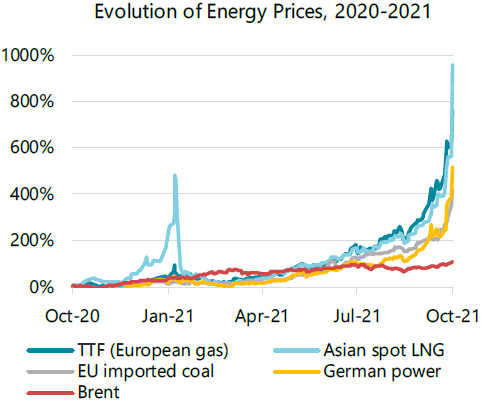How the energy crisis affected Europe and the impact of coal
Published by: 10.11.2021 14:55:08
Europe's energy crisis is deepening and gas and electricity prices have reached new records after the US warned that the continent is not doing enough to prepare for a potentially troubled winter.
With roughly a month to go before the heating season begins, Europe does not have enough natural gas in storage, nor is it building up inventories fast enough. Amos Hochstein, the U.S. State Department's envoy for energy security, said he is worried about supplies for this winter.
As economies reopen and people return to the office, energy demand is rebounding around the world. The rise in European energy prices is just a taste of what is to come for other commodities.
China, too, has a shortage of coal, which powers much of the economy there.
Alternative sources for electricity generation are currently insufficient to meet high demand.
Therefore, reduced electricity generation is causing outages at many manufacturing plants, including those that process silicon.
There is therefore a further deepening of the semiconductor crisis and a possible rise in prices on the horizon.
At the same time, the whole world depends on the supply of materials and products from China.

The genesis of the current energy crisis must be traced back to previous policies aimed at reducing the huge emissions of carbon dioxide into the atmosphere. The world wanted to move away from coal and towards low-carbon energy sources such as gas or renewable energy. Add to all this Brexit, which has had a huge impact on the current crazy situation in the UK, the economic slowdown caused by the coronavirus, which has only led to a temporary reduction in demand for energy sources, and the key and least predictable factor - the weather.
The previous winter saw stocks of gas and other raw materials used to generate heat fall to their lowest levels in years. The coronavirus has led to a reduction in economic activity in many sectors, causing a reduction in demand for energy production. This has led to a decline in the flow of raw materials around the world. Gas and coal reserves in Europe or Asia have not been able to recover during the period of increased activity.

Gas storage utilisation in Europe is currently only 74%, compared to a five-year average of 89%. According to the EIA, if the coming winter is severe, then some areas may face commodity shortages. This is currently the case in the UK, where supplies are depleted and demand is still rising.
Energy commodity prices have increased by as much as several hundred percent in recent months. This is the result of shortages artificially limiting supply, but above all of a dynamic recovery in demand. Energy prices will affect virtually all aspects of the economy.
Fossil Coal
<
Butanother factor is the local government's efforts to reduce its carbon footprint in order to reduce the industry's impact on the global climate. Indeed, according to available information, up to 60% of the Chinese economy is powered by coal. Coal is the feedstock for a significant number of Chinese power stations, and is currently the so-called 'dirtiest' way of generating electricity.
Chinese President Xi Jinping, meanwhile, has pledged that his country wants to become carbon neutral by 2060. As a result, China is set to exert increasing pressure in the coming years to reduce coal-fired power generation and favour "greener alternatives".
Coal powers most of China's economy, which has a drastic impact on the environment.
But as the country has seen, current alternative resource capacity is insufficient. The result, therefore, is that the country is struggling with electricity shortages. This has resulted in curtailing the output of many factories that depend on it. And the latest victim is the silicon plants.
The strong drive to reduce carbon dioxide emissions, mainly in Europe but increasingly also in Asia, has led to a bias towards renewable energy generation. Rising prices for carbon dioxide permits have led to a shift away from coal towards gas and renewables. However, renewables are weather dependent - in Britain there is no wind, while in Norway low water levels have led to increased demand for conventional energy sources. So prices are rising not only for gas, which is currently scarce on the market (due to earlier consumption and supply problems), but also for coal. High energy prices are the result of a spiral related to the price of emission permits and high energy commodity prices.
High energy prices raise inflation expectations, leading to higher bond yields. This in turn has a huge impact on the dollar (upside outlook), gold (downside outlook) and stocks, especially technology (downside outlook).
Documents to download
K&L Rock also declares that it is not liable for any direct or indirect damage resulting from trading on the capital markets in general, and posts in discussions expressing the views of readers may not be in line with the operator's position and therefore cannot be regarded as its views.



